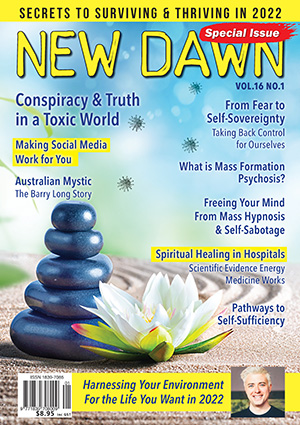From New Dawn Special Issue Vol 16 No 1 (Feb 2022)
You are the product. Your personal data are sold to brokers and advertisers against your informed consent to profit the uber-rich, like Facebook’s (now “Meta”) co-founder, Mark Zuckerberg.1 But it gets worse. Much worse. Your very reputation as a human is built or demolished on “social media” as it is sold to prospective employees, lenders, and landlords.2
So-called social media, which are really anti-social media,3 are merging into the tech-pharma industrial complex. They are creating a biofascist system in which your body and behaviour are potential money-makers for tech monopolies. The artificial intelligence (AI) economy is morphing into the “internet-of-bodies,” where genetic engineers and for-profit health companies will acquire all-pervasive, ubiquitous data about your most personal information.4 Not only this, but anticipatory artificial intelligence markets are under development.
GRIM FUTURE… AND PRESENT
In these future markets, the omnipresent surveillance will be fed to algorithms programmed to guess your mood, reactions, and thoughts. We can imagine the nightmarish social applications.5 In public spaces, individuals with anxiety, for instance, might be analysed by AI, which could send adverts for stress pills to their phones, while security guards are dispatched to detain the individual, suspecting them of plotting crimes. Any public performance by, for instance, a populist politician will see their every facial and bodily movement scrutinised by behavioural AI in real-time for the public to assess and judge. Mainstream media delivering the given political debate will rank the “confidence” and “calmness” of the favoured candidate higher than those of the underdog, shattering voter confidence in the populist.
The present is already grim enough. Generation Z and the maturing Generation Alpha (perhaps named accordingly to anticipate and create generational divisions?)6 were born and are being born into a connected world, never knowing a moment of being off-line or having to wait for gratification.
Early so-called social media appealed to users’ egos; YouTube, MySpace. But they also played on our need, as humans, to be part of communities. “Social media” liberated the individual from the physical and restricting geography of their dwellings, but also from their cultures. The lonely and misunderstood teen could find the kinds of like-minded people online that they could not at school or in their hometown. The niche hobbyist could do likewise. The conformist could post about themselves to receive validation from fellow conformists.7
But users initially had no clue that their habits, connections, thoughts, interests, and posts were being harvested for profit. They had no idea that the military-intelligence complex was also hoovering up their data to build character profiles and engineer society. Pretty soon, users entered carefully crafted filter bubbles in which ever-increasing niche trends of favoured sites, products, “friends,” and personalities would play up to those traits to attract more users to the bubble. Behind the scenes, social media companies worked with cognitive psychologists to devise ways of keeping users addicted to their devices by simple reward-based conditioning (a dopamine hit from getting “likes,” a serotonin rise from checking inboxes, etc.).

Anti-social media became weapons. When the Obama administration wanted to topple the regime of Hosni Mubarak in Egypt, it trained hordes of social media users8 to radicalise the peoples of Egypt to risk their lives to remove the dictator. But it was a trap. The US and Britain did not want “democracy” in Egypt. After Mubarak resigned, they fully backed the military under General al-Sisi against the democratically-elected government of Mohamed Morsi, who was soon deposed. The same occurred in Libya against Muammar Gaddafi. In Cuba, the CIA set up a fake Twitter-type social media app, ZunZuneo, against the Castro dynasty, their long-time target.9 Today, anybody or any organisation too far left or right is censored, “fact-checked,” and de-platformed, including the President of the USA.
As the tech-pharma complex imposes its biofascist framework on the world, anybody who opposes, questions, or investigates alleged health mandates is directed to the approved narrative or shut down entirely. But it doesn’t have to be this way. Nothing in this system is yours. Money is not your invention. You did not design or build the roads on which you walk, nor the computers on which you work. You may have voted for a politician, but you have no input in the political system beyond putting a cross periodically on a piece of paper. Nothing is yours, yet everything about you is theirs: where you live (census), your present space (geolocation), your physical health (medical records), your working, leisure, and buying habits (online data).
There is no balance in this equation. However, we still use the system that we did not invent and over which we have no control to benefit ourselves. The same can be said of “social media”: they use us, we don’t use them; but we could strategically use them to our advantage, like an army capturing a piece of enemy technology. How do we do it? It depends on who we are and what interests us.
DETOX: RETRAIN YOUR BRAIN
The social media companies with the most active users are as follows: Facebook (Meta, 2.8 billion users), YouTube (2.2bn), WhatsApp (owned by Meta, 2bn), Instagram (Meta, 1.3bn), Messenger (Meta, 1.3bn), WeChat (1.2bn), and TikTok (1bn). Other companies like Douyin, QQ, Sina Weibo, Telegram, and Snapchat have less than half of the market share of most of the above companies.10 With 400 million worldwide users, Twitter is nothing compared to FB. Seventy-seven million Americans use Twitter compared to over 200 million who use FB.11 Eight in 10 FB users access the site on a mobile device, not computer/laptop. Over 11 million Australians use FB compared to 4.6 million who use Twitter.12
More males than females use Facebook. Worldwide (Australia included),13 it is most popular among the 18 to 24 age group (a fifth of people in this age range use it, 9 per cent females, 13 males) and the 25 to 34 age group (a third use it, 12 per cent female, 19 male).14 The numbers are surprisingly similar for US FB users, where given the larger number of connected people (compared to, say Africa,) we could expect FB user numbers to be larger.15 Seven in 10 American adults use Facebook. Nearly half of the company’s revenue comes from North America, with 40 per cent of US ad revenue coming from Instagram. The average user clicks on 12 adverts per month, and 75 per cent click on local business pages.16 Given their monopolies over the so-called market, when talking about western social media we really mean FB and YouTube.
Seven in 10 Americans of all ages between 15 and 56+ use YouTube.17 Like FB, slightly more users are male than female. Two billion people visit YouTube per month, spending an average of 18 minutes per day on the site. User time on YouTube varies. Millennials, for instance, have a higher tendency to binge on content than younger or older viewers.
Social media companies sell user attention for advertisers. The more attention you give your phone, the more money FB et al. raise in ad revenue, hence their designers’ purposeful engineering of addiction into the architecture of their software. Before the pandemic, more than six in 10 Americans checked their phones 160 times a day, of whom 65 per cent checked the phone at night. One third spend more time with their phone than with their partner, and nearly half would rather give up sex for a year than their phone.18 By 2018, British users checked their phones every 12 minutes.19 The FB engineers have exploited three of the brain’s four dopamine pathways, the so-called neurotransmitters: the mesocortical, mesolimbic, and nigrostriatal. The more responses that stimulate rewards, the stronger the long-term potentiation (the strengthening of neural connections). Through a process called reward prediction error encoding, the brain can anticipate that it will receive a dopamine reward from an external stimulus.20
A recent study claimed that taking a break from social media, otherwise known as a digital detox, did nothing to improve mood. But the study was flawed. The length of the detox was short. It is well-known that addicts experience initial withdrawal symptoms that make them unhappy in the short term.21 Other studies that include these key considerations suggest that longer-term digital detox works. For example, the so-called “fear of missing out” factor was paired with the user’s sense of social connectedness and mental wellbeing. For most participants, a seven-day social media absence significantly increased mental wellbeing and, to an extent, social connectedness; which is interesting because social media are supposed to connect us, so we would expect the feeling of social connectedness to decline during detox. But what happens is that real social connectedness starts to occur.22
BEAT THE ALGORITHMS
Now that you have detoxed and reprogrammed your brain against those dopamine hits, you can use social media in a disciplined and constructive way: to organise protests, share real news, and create original content. How can these things be achieved when the tech giants are censoring everyone except the neoliberal-approved “centre”? So-called “fringe” terms flagged by Google, for instance, include “who shot JFK,” “proof earth is flat,” “do vaccines cause autism,” and “is global warming real” (sic). Google’s so-called “conspiracies & fake news” topics include “Vaccines: The truth behind vaccinations.”23
There are alternative search engines, though researchers note that they yield poor results because they cannot compete with Google’s computing power. The paradox, however, is that Google censors content. To avoid the strike-through, in which Google displays results not entirely relevant to your search, put each key phrase into inverted commas. Try changing your location, as results vary according to region. To avoid being successfully profiled, regularly search for things you are not really interested in. Wipe your cookies and browser history each day. None of the above presents a perfect solution to beating censors, remaining anonymous, or confusing the algorithms, but they can at least limit the power that these monopolies have over you and your browsing experience.
In addition to using alternative search engines like DuckDuckGo, avoiding the censors is possible when creating and sharing content.
One publication suggests five ways to beat the algorithms. Some might not be relevant now if buttons and programmes have changed, but the creative solutions can inspire ways to defeat the system. 1) Activate the “most recent posts” FB function by tapping the See More function so that you are not limited to posts the algorithm is programmed to promote. 2) Because FB is driven by the popularity of the page, person, and content, add friends and pages to Favourites so that the algorithm drives their content to your notifications. 3) Post screenshots instead of text of content dubbed “fake news” by the system. Programmes are less good at scanning images than text. 4) Engage with your political opposites to create an algorithmic crossover so that your content is less likely to be censored. 5) Send alerts out to smaller groups to limit the chance of the algorithm listing your content as spam.24

Following America’s Israel policy, FB has deleted and censored anti-occupation accounts and pages, but Arabic-speaking peoples have beaten the anti-Palestine robots by using old Arabic fonts that the software can’t recognise. We could take a cue from this and find ways to create content with fonts that algorithmic eyes cannot understand.25
It is feasible to communicate with deepfake amateurs to create algorithm-beating political content modified enough to evade censors but not so much that the human user doesn’t understand. For instance, a deepfake-modified video of a prominent “vaccine”-sceptic might be tweaked to make it appear that they are talking about something else, though those sharing the content know what the video really refers to. The sceptic’s face could be altered so that the system doesn’t recognise and flag them. Trigger words like “vaccine” could be replaced with something unrelated like “orange juice.” Chinese dissidents beat the censors with similar techniques.26
Social media and indeed the very architecture of smartphones means that it’s not just users’ online activities that are being monitored. Phones are designed to create a digital trail of your physical movements. In so-called western democracies, police have identified protestors from their locations at particular times from data gleaned from those protestors’ phones. For instance, prior to the G8 summit in Heiligendamm (Germany) in June 2007, one thousand police raided the homes of 40 activists from data acquired from intercepted telecommunications.27 Similar tactics are being used in western “democracies” to surveil and arrest protestors opposing injection mandates and lockdowns.
Civil liberties organisations offer advice to demonstrators on how to evade detection. Tips include turning off the location (though signals can still be triangulated), particularly when posting from a particular location to social media,28 downloading encrypted messaging applications such as Signal and Threema,29 and, of course, keeping your phone in a separate room when having conversations because the microphone is recording.30
Harnessing Informational Tools
As programmes and moderators become increasingly censorious – i.e., Google memory-holing content, Facebook sending users to digital prison, YouTube demonetising original work as punishment for non-conformity – it is important to go to other social media platforms: Bitchute, Gab, Telegram, Parler, Rumble. But this itself creates a dialectic in which everything bland, PR-friendly, and pro-corporate is permitted to appear on the monopoly platforms, and everything else jumps ship to alternative sites. Just as the monopolies create echo-chambers of dullness in which corporate media content is promoted over independent producers whose work gains grassroots momentum, filter-bubbles are generated on alternative platforms. It is, therefore, important to recognise and be suspicious of the motives of those posting on such sites. It is easy to get sucked into rabbit holes as a consequence of avoiding the ever-restrictive social media giants.
The political left has not helped itself in this regard. It has been quick to de-platform. Not only has the left found itself being de-platformed by corporate monopolies, but it has also helped push the political right into a new social media sphere in which ideas are reinforced instead of being challenged.
This is a perfect dialectic for our rulers, who paint everything as a battle between good and evil, ignoring the bad on all sides and good on all sides. In this age of biofascist control, we must find the good on each side and use informational tools to fight the new tech-pharma complex.
Footnotes
1. Stephen Beake (2014) Data Brokers and the Need for Transparency and Accountability, Nova Scientific
2. Nora A. Draper (2019) The Identity Trade: Selling Privacy and Reputation Online, New York University Press
3. Siva Vaidhyanathan (2018) Antisocial Media: How Facebook Disconnects Us and Undermines Democracy, Oxford University Press
4. Eleonore Pauwels and Sarah W. Denton (2018) “Searching for privacy in the internet of bodies,” Wilson Quarterly, www.wilsonquarterly.com/quarterly/living-with-artificial-intelligence/searching-for-privacy-in-the-internet-of-bodies
5. Kate Crawford, “Time to regulate AI that interprets human emotions,” Nature, 6 April 2021, www.nature.com/articles/d41586-021-00868-5
6. Caroline Bologna, “What’s The Deal With Generation Alpha?,” Huffington Post, 11 August 2019, www.huffpost.com/entry/generation-alpha-after-gen-z_l_5d420ef4e4b0aca341181574
7. Educational, Psychological and Behavioral Considerations in Niche Online Communities, Information Science Reference
8. James K. Glassman, “Public Diplomacy 2.0: A New Approach to Global Engagement,” US Department of State, 2001-2009.state.gov/r/us/2008/112605.htm
9. Associated Press, “US secretly created ‘Cuban Twitter’ to stir unrest and undermine government,” Guardian, 3 April 2014, www.theguardian.com/world/2014/apr/03/us-cuban-twitter-zunzuneo-stir-unrest
10. Statista, “Global social networks ranked by number of users 2021,” 16 November 2021, www.statista.com/statistics/272014/global-social-networks-ranked-by-number-of-users
11. Statista, “Leading countries based on number of Twitter users as of October 2021,” 19 November 2021, www.statista.com/statistics/242606/number-of-active-twitter-users-in-selected-countries
12. FIBER Marketing, www.fiber.com.au/post/social-media-statistics-worldwide-australia
13. Thomas Hinton, “Distribution of Facebook users in Australia 2021, by age and gender,” Statista, 15 October 2021, www.statista.com/statistics/680607/australia-facebook-user-distribution-by-age-and-gender
14. Statista, “Facebook: distribution of global audiences 2021, by age and gender,” 19 November 2021, www.statista.com/statistics/376128/facebook-global-user-age-distribution
15. Statista, “Facebook user share in the United States 2021, by age group,” 15 October 2021, www.statista.com/statistics/187549/facebook-distribution-of-users-age-group-usa
16. Salman Aslam, “63 Facebook Statistics You Need to Know in 2021,” Omnicore, 4 January 2021, www.omnicoreagency.com/facebook-statistics
17. L. Ceci, “YouTube usage penetration in the United States 2020, by age group,” 19 October 2021, www.statista.com/statistics/296227/us-youtube-reach-age-gender
18. Gabrielle Pickard-Whitehead, “66% of Americans Check Phone 160 Times a Day, Here’s How Your Business Can Benefit,” Small Business Trends, 3 March 2020, smallbiztrends.com/2020/03/2020-mobile-phone-usage-statistics.html
19. Press Association, “Brits Now Check Their Mobile Phones Every 12 Minutes,” 2 August 2018, www.huffingtonpost.co.uk/entry/brits-now-check-their-mobile-phones-every-12-minutes_uk_5b62bf60e4b0b15aba9fe3cb
20. Trevor Haynes, “Dopamine, Smartphones and You: A battle for your time,” Harvard University, May 2018, sitn.hms.harvard.edu/flash/2018/dopamine-smartphones-battle-time
21. Andrew K. Przybylski, Thuy‑vy T. Nguyen, Wilbert Law, and Netta Weinstein (2021) “Does Taking a Short Break from Social Media Have a Positive Effect on Well‑being? Evidence from Three Preregistered Field Experiments,” Journal of Technology in Behavioral Science, 6: 507-14
22. Lorna Brown and Daria J. Kuss (2020) “Fear of Missing Out, Mental Wellbeing, and Social Connectedness: A Seven-Day Social Media Abstinence Trial,” Environmental Research and Public Health, 17(4566): doi:10.3390/ijerph17124566
23. Google, “Fringe ranking/classifier: Defining channel quality,” Google Groups, “Breitbart and Google Ads,” February 2017, fdocc2.wordpress.com/2020/08/31/here-in-pdf-the-full-set-of-zach-vorhies-released-from-google-dont-be-evil-files-a-whistleblower-denouncing-the-current-criminal-removal-of-truths
24. Andy Hogue, “Combat Facebook Censorship With These 5 Simple Steps,” The Hayride, 23 September 2020, thehayride.com/2020/09/combat-facebook-censorship-with-these-5-simple-steps
25. Mustafa Abu Sneineh, “Facebook users deploy old Arabic font to bypass algorithm, support Palestinians,” Middle East Eye, 23 May 2021, www.middleeasteye.net/news/israel-palestine-facebook-algorithm-old-arabic-font
26. Ritu R. Patil (2014) “A Method to Evade Keyword Based Censorship,” Master’s thesis, University of Texas at Arlington, rc.library.uta.edu/uta-ir/bitstream/handle/10106/24979/Patil_uta_2502M_12978.pdf
27. Ben Hayes, “NeoConOpticon: The EU Security-Industrial Complex,” Transnational Institute and statewatch, June 2009, statewatch.org/media/documents/analyses/neoconopticon-report.pdf, p. 68
28. Privacy International, “How social media monitoring can be used at a protest,” 6 May 2021, privacyinternational.org/explainer/4509/how-social-media-monitoring-can-be-used-protest
29. Amelia Nierenberg, “Signal Downloads Are Way Up Since the Protests Began,” New York Times, 12 June 2020, www.nytimes.com/2020/06/11/style/signal-messaging-app-encryption-protests.html
30. Kim Komando, “You’re not paranoid: Your phone really is listening in,” USA Today, 19 December 2019, eu.usatoday.com/story/tech/columnist/2019/12/19/your-smartphone-mobile-device-may-recording-everything-you-say/4403829002
© New Dawn Magazine and the respective author.
For our reproduction notice, click here.



